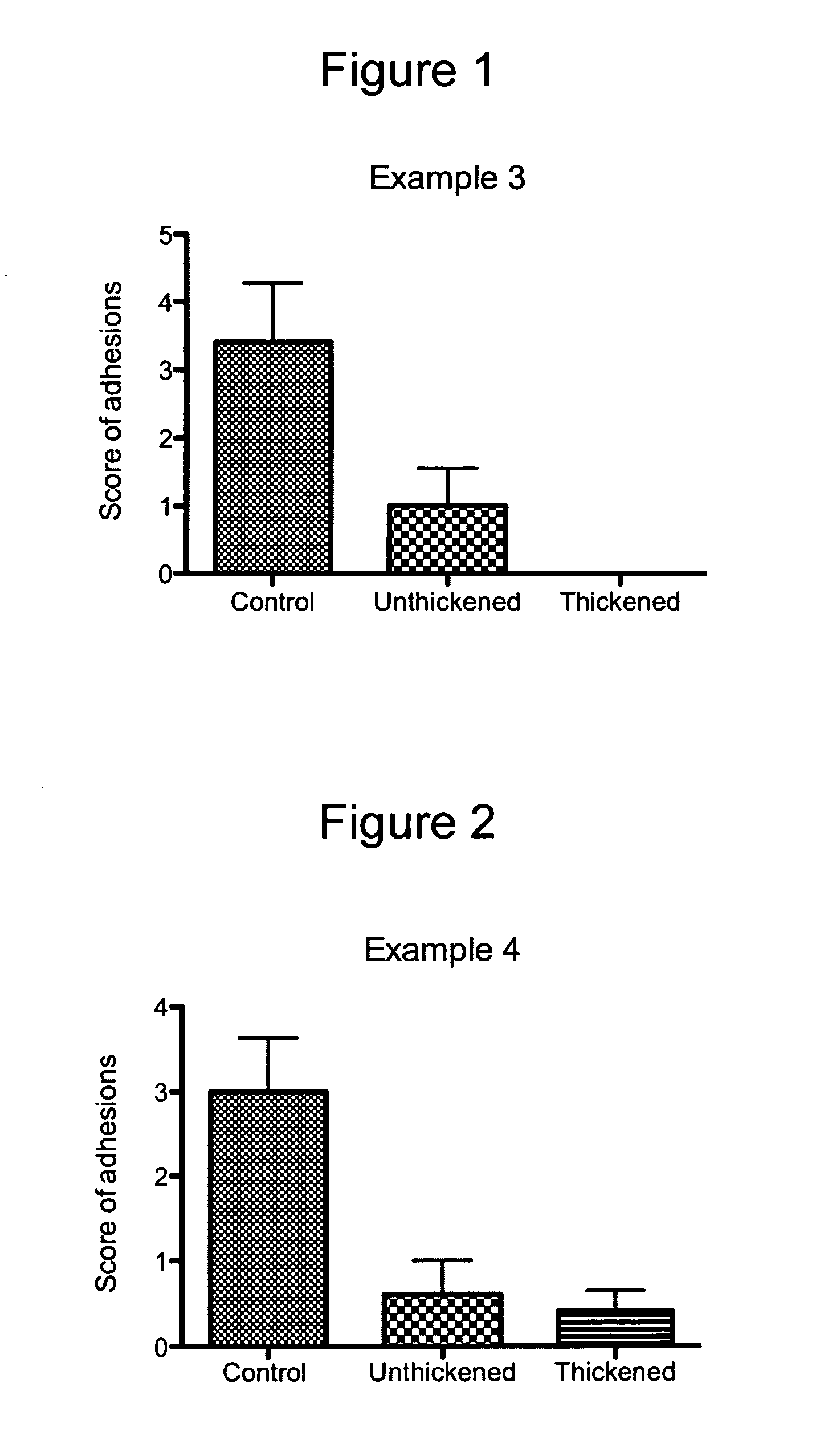Method for suppressing or preventing fibrous adhesion formation using a multicomponent aqueous oxychlorine composition prepared on-site
a technology of oxychlorine and composition, which is applied in the field of preparation of oxychlorine formulations, can solve the problems of attending pain, increasing the difficulty of any particular surgical case, and lingering postoperative adhesions
- Summary
- Abstract
- Description
- Claims
- Application Information
AI Technical Summary
Benefits of technology
Problems solved by technology
Method used
Image
Examples
example 1
[0112]
OXYCHLORINE GENERATION STUDIES WITH VARYING CHLORITE, ACID, AND HYPOCHLORITE LEVELSSodium Chlorite (pure basis)Residual HOCl / VOLUME (ml)*as ClO2−VolumeClO2−Order of AdditionClO2 formedInitialas ClO2−CalculatedAnalysisConversionRatioAdequacySol'nRUNABCppmmg / 500 m1mg / 500 mlppmEfficiencyB / A%pHα155111.855.913499.94416.38832.556.0%5:172.75.76β0.52.52.552.426.26750.023.816.44832.852.4%5:172.76.00γ12.52.560.130.013499.969.964.514012930.0%2½:136.46.35δ0.55540.020.06750.0(27.0)NA**(54.0)NA**59.7%10:1 145.45.54*per 500 ml of saline**NA-not analyzed: The solution's chlorine-like odor, from both C lO2 and hypochlorite, could not be dispelled by aeration, as in the other samples. There is little likelihood of residual chlorite with excess hypochlorite present.A = Sodium chlorite; 134 mg / ml of water (pure basis)B = 0.60% sodium hypochlorite / 0.60% sodium carbonate.C = 2.0% citric acid solution.
[0113]In this example, it can be seen that the least efficient conversion to ClO2 occurs in run γ w...
example 2
[0115]
OXYCHLORINE GENERATION STUDIES USING TWO-PART ACTIVATOR; OXYCHLORINE (OX) AND CITRIC ACID (CA) MIXSodium Chlorite (pure basis)ResidualClO2−ClO2:ClO2−VolumeVOLUME (ml)ClO2 formedInitialas ClO2−By analysisMolarRatioSol'nRUNOXCAppmmg / 500 mlmg / 500 ml ppmRatioOX / CApHI5.05.0112.456.213499.921.743.43.441:15.76II2.52.552.126.16750.032.364.70.811:16.00III2.52.557.728.96750.031.162.20.931:16.35
added to convert the hypochlorite to hypochlorous acid. Two identical solutions (i.e., same concentrations of all ingredients) were evaluated, with the only difference being the uniformity of acidification. As has been shown in the body of this disclosure, there is a reaction between hypochlorite and chlorite which minimizes ClO2 formation in favor of chlorate and chloride ions, i.e., HOCl+ClO2−+OH−→ClO3−+Cl−+H2O. In the controlled addition (Run III below), the saline / oxychlorine composition was stirred while the acid was being introduced, in an attempt to lower the pH quickly and uniformly throug...
example 3
[0123]This example is provided to demonstrate the marked effect of the ClO2-oxychlorine systems on the formation of post-surgical adhesions in a group of mammalian species. The treatment solutions, unthickened and thickened, were prepared using the sequential three-solution injection system into sterile saline solution. The solution ratios paralleled that shown in Example 1, run α. Abdominal adhesions were produced in three groups of male Wistar rats (200-230 g, 10 weeks old, feed with Purina chow and water ad libitum, subjected to light-dark cycles of 12×12 h) following the model reported by Buckenmaier et al. There were five animals per each of the three groups. In brief: the animals were anesthetized (pentobarbital 45 mg / kg, intraperitoneal, i.p.), the lower abdominal area was shaved, washed and cleaned with povidone iodine. A laparotomy was done through a midline incision. The parietal wall of the peritoneum was exposed and four vessels were located (the distances between the ve...
PUM
| Property | Measurement | Unit |
|---|---|---|
| pKa | aaaaa | aaaaa |
| concentration | aaaaa | aaaaa |
| concentration | aaaaa | aaaaa |
Abstract
Description
Claims
Application Information
 Login to View More
Login to View More - R&D
- Intellectual Property
- Life Sciences
- Materials
- Tech Scout
- Unparalleled Data Quality
- Higher Quality Content
- 60% Fewer Hallucinations
Browse by: Latest US Patents, China's latest patents, Technical Efficacy Thesaurus, Application Domain, Technology Topic, Popular Technical Reports.
© 2025 PatSnap. All rights reserved.Legal|Privacy policy|Modern Slavery Act Transparency Statement|Sitemap|About US| Contact US: help@patsnap.com



